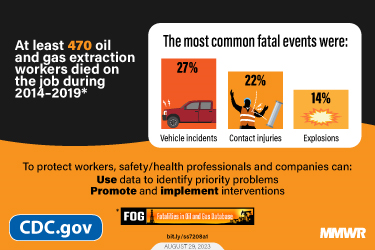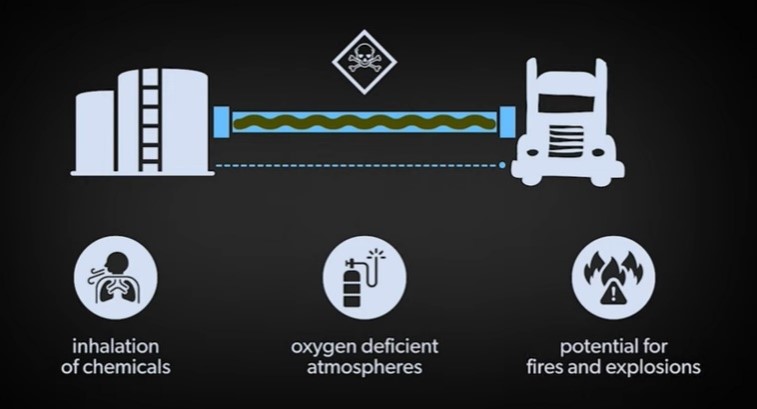Using Public Health Data to Protect Workers in the Oil and Gas Extraction Industry
Posted on by
Oil and gas extraction (OGE) workers play an important role in supporting the U.S. economy. In 2021, 326,160 workers were employed by OGE companies to help meet U.S. energy needs.1 This work is not done without risk. Workers in the OGE industry regularly face hazardous exposures such as flammable and toxic gases and vapors, and high-risk environments such as working at heights, around heavy equipment, below suspended loads, with explosive materials, and around pressurized lines and vessels. In addition, well sites are temporary worksites, creating highly dynamic work conditions and hazards. This workforce faces elevated occupational fatality rates that are consistently higher than the rate for all U.S. workers.2
 To better understand the factors placing OGE workers at higher risk for fatality, in 2013 researchers from the NIOSH Oil and Gas Extraction Program worked with industry partners through the National Occupational Research Agenda OGE Sector Council to develop the Fatalities in Oil and Gas Extraction (FOG) database. The FOG database is a worker fatality surveillance system used to identify safety and health trends and emerging issues among OGE workers. The database contains industry-specific variables on OGE worker deaths from 2014–2019. A recent article published in the Centers for Disease Control and Prevention’s Morbidity and Mortality Weekly Report describes the development of the database.
To better understand the factors placing OGE workers at higher risk for fatality, in 2013 researchers from the NIOSH Oil and Gas Extraction Program worked with industry partners through the National Occupational Research Agenda OGE Sector Council to develop the Fatalities in Oil and Gas Extraction (FOG) database. The FOG database is a worker fatality surveillance system used to identify safety and health trends and emerging issues among OGE workers. The database contains industry-specific variables on OGE worker deaths from 2014–2019. A recent article published in the Centers for Disease Control and Prevention’s Morbidity and Mortality Weekly Report describes the development of the database.
This blog aims to raise awareness about the FOG database and demonstrate how having industry-specific public health data is beneficial to protecting workers.
Contributions to Research
Heat Stress
The majority of OGE work occurs in outdoor environments and involves strenuous, physically demanding work for extended periods of time. Temperatures in the regions where OGE work occurs routinely surpass 100 degrees Fahrenheit (°F). A recent report used the FOG database to identify common risk factors for heat-related fatalities among OGE workers. This report identified nine fatalities related to heat stress from January 2015-May 2021. Risk factors for fatalities among OGE workers included being a new hire and therefore not acclimatized to heat, inadequate training on heat stress and heat-related illness, underlying hypertension or arteriosclerotic cardiovascular disease, and amphetamine use. It will be important for the OGE industry to control these risk factors as extreme heat conditions become more common, as industry activity increases, and new employees who are not acclimatized to working in high temperatures join the industry.3
Substance Use
In addition to the strenuous, physically demanding work, OGE work commonly involves long hours, shift work, irregular schedules, and long commutes, which are risk factors for substance use.4-6 A recent report described fatalities involving substance use using data from the FOG database. In this report central nervous system stimulants (e.g., methamphetamine or amphetamines) were identified as the most common substance reported among the fatally injured workers. This indicates the need for additional research examining workplace overdose deaths, the work-related risks of both legal and illicit substance use, and the impact of increased access to substance use disorder treatment among OGE workers.
Cardiovascular Disease
The characteristics of OGE work previously mentioned for the heat related and substance use related deaths, have also been associated with cardiovascular disease and sudden cardiac events.7 Additionally, OGE workers face possible exposures to hydrocarbon gases and vapors, which can increase the risk of sudden cardiac death.8 It is not uncommon for OGE workers to work alone and in remote locations without adequate access to medical care.9 The FOG database was used to examine fatal cardiovascular events in OGE workers and found the need for cardiovascular disease prevention and treatment, emergency preparedness, lone worker programs, medical screening, and enhanced exposure control in the OGE industry.7
Hydrocarbons Gases and Vapors (HGVs)

NIOSH researchers, working alongside the Occupational Safety and Health Administration (OSHA) and an occupational medicine physician, used the FOG database and other sources to identify and describe the circumstances of nine OGE workers who died from confirmed or suspected exposure to HGVs while manually gauging tanks during 2010—2015.8 Opening hatches on production tanks releases a plume of HGVs creating a highly flammable and oxygen-deficient environment. This simultaneous exposure of HGVs combined with a low oxygen atmosphere can pose a risk of sudden cardiac death to workers who manually gauge tanks.8 The discovery of this previously unreported risk led to the development of a new safety standard by the American Petroleum Institute in 2016 describing alternative ways to gauge a tank without opening the tank hatch in order to protect workers.10
Other Uses
The FOG database has been used to develop several hazard alerts in collaboration with OSHA, NIOSH, and the National Service, Transmission, Exploration and Production Safety Network Alliance. The Alliance hazard alerts describe a variety of known hazards and provide recommendations for employers and workers for improving safety at work. These hazard alerts are available in both English and Spanish and have been disseminated to tens of thousands of workers.
A complete list of all products related to the FOG database can be found here.
How can my company learn from the FOG database?
Key variables from the FOG database were added to the NIOSH Worker Health Charts in 2023 to make FOG data more accessible. Through the Worker Health Charts, users can create their own data queries and charts using FOG data to assess trends and gain insight on the OGE industry. We encourage you to explore the FOG data and provide your feedback in the comments below.
Let us know in the comments below how you think findings from FOG could inform proactive and preventative measures for oil and gas worker health and safety.
For any inquiries regarding the FOG database contact the NIOSH OGE Program at nioshoilandgas@cdc.gov.
Alejandra Ramirez-Cardenas, MPH, is an Epidemiologist in the NIOSH Western States Division.
Kait Wingate, MPH, is a contractor with Synergy America, Inc. serving as an Epidemiologist with the NIOSH Western States Division.
References
- Quarterly Census of Employment and Wages. Washington, DC: Bureau of Labor Statistics; 2022.
- Mason KL, Retzer KD, Hill R, Lincoln JM. Occupational fatalities during the oil and gas boom–United States, 2003-2013. MMWR Morb Mortal Wkly Rep. May 29 2015;64(20):551-4.
- Scott KA, Bushnell T. Oil and Gas Workers Count. NIOSH Science Blog. January 23, 2023. https://blogs.cdc.gov/niosh-science-blog/2023/01/23/oge-workers/
- Hagan-Haynes K, Ramirez-Cardenas A, Wingate KC, et al. On the road again: A cross-sectional survey examining work schedules, commuting time, and driving-related outcomes among U.S. oil and gas extraction workers. Am J Ind Med. Jun 23 2022;doi:10.1002/ajim.23405
- Hagan-Haynes K, Pratt S, Lerman S, Wong I, Baker A, Flower D, Riethmeister V. US research needs related to fatigue, sleep, and working hours among oil and gas extraction workers. Am J Ind Med. 2022 Nov;65(11):840-856. doi: 10.1002/ajim.23310. Epub 2021 Nov 14. PMID: 34775611.
- Ramirez-Cardenas, Alejandra MPH; Wingate, Kaitlin C. MPH; Pompei, Richard DO, MPH; King, Bradley PhD, MPH; Scott, Kenneth A. PhD, MPH; Hagan-Haynes, Kyla MPH; Chosewood, L. Casey MD, MPH. Fatalities Involving Substance Use Among US Oil and Gas Extraction Workers Identified Through an Industry Specific Surveillance System (2014–2019). Journal of Occupational and Environmental Medicine 65(6):p 488-494, June 2023.
- Zimmerman SM, Scott KA, Wingate KC, Ramirez-Cardenas A, Pompei R, Hagan-Haynes K, Hill RD, Wood E. Working Alone and/or in Remote Locations: Opportunities to Prevent the Risk of Fatality From Cardiovascular Events in Oil and Gas Extraction Workers. J Occup Environ Med. 2023 Jun 1;65(6):481-487. doi: 10.1097/JOM.0000000000002851. Epub 2023 Mar 24. PMID: 36962079; PMCID: PMC10239358.
- Harrison RJ, Retzer K, Kosnett MJ, et al. Sudden Deaths Among Oil and Gas Extraction Workers Resulting from Oxygen Deficiency and Inhalation of Hydrocarbon Gases and Vapors — United States, January 2010–March 2015. MMWR Morb Mortal Wkly Rep 2016;65:6–9. DOI: http://dx.doi.org/10.15585/mmwr.mm6501a2
- Scott, KA, Elliott, KC, Lincoln, J, Flynn, MA, Hill, R, Hall, DM. Rural health and rural industries: Opportunities for partnership and action. J Rural Health. 2023; 15.
- National Institute for Occupational Safety and Health (NIOSH). A story of impact: NIOSH and partners work to prevent worker deaths from exposures to hydrocarbon gases and vapors at oil and gas wellsites. Atlanta, GA: US Department of Health and Human Services, CDC, National Institute for Occupational Safety and Health; 2016. https://www.cdc.gov/niosh/docs/2017-110/pdfs/2017-110.pdf?id=10.26616/NIOSHPUB2017110
Posted on by

